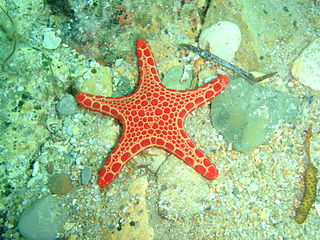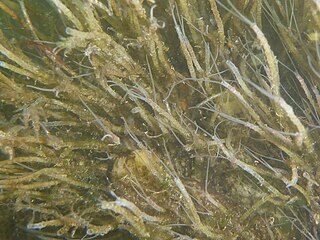
An echinoderm is any deuterostomal animal of the phylum Echinodermata, which includes starfish, brittle stars, sea urchins, sand dollars and sea cucumbers, as well as the sessile sea lilies or "stone lilies". While bilaterally symmetrical as larvae, as adults echinoderms are recognisable by their usually five-pointed radial symmetry, and are found on the sea bed at every ocean depth from the intertidal zone to the abyssal zone. The phylum contains about 7,000 living species, making it the second-largest group of deuterostomes after the chordates, as well as the largest marine-only phylum. The first definitive echinoderms appeared near the start of the Cambrian.

Starfish or sea stars are star-shaped echinoderms belonging to the class Asteroidea. Common usage frequently finds these names being also applied to ophiuroids, which are correctly referred to as brittle stars or basket stars. Starfish are also known as asteroids due to being in the class Asteroidea. About 1,900 species of starfish live on the seabed in all the world's oceans, from warm, tropical zones to frigid, polar regions. They are found from the intertidal zone down to abyssal depths, at 6,000 m (20,000 ft) below the surface.

Goniasteridae constitute the largest family of sea stars, included in the order Valvatida. They are mostly deep-dwelling species, but the family also include several colorful shallow tropical species.

Culcita schmideliana, commonly known as the spiny cushion star, is a species of pin-cushion star. It has a variety of base colors and often patches of a different color. It is pentagonal in shape and lives in the tropical Indo-Pacific. This species is rarely kept by hobby aquarists.

The leather star is a sea star in the family Asteropseidae found at depths to 100 m (328 ft) off the western seaboard of North America. It was first described to science by Adolph Eduard Grube in 1857.

Leptasterias is a genus of starfish in the family Asteriidae. Members of this genus are characterised by having six arms although five-armed specimens sometimes occur. L. muelleri is the type species. The taxonomy of the genus is confusing and Leptasterias hexactis seems to be a species complex. Some species brood their eggs.

Leptasterias hexactis is a species of starfish in the family Asteriidae, commonly known as the six-rayed star. It is found in the intertidal zone of the western seaboard of the United States. It is a predator and is unusual among starfish in that it broods its eggs and young.

Solaster stimpsoni, common names Stimpson's sun star, sun star, orange sun star, striped sunstar, and sun sea star, is a species of starfish in the family Solasteridae.

Evasterias troschelii is a species of starfish in the family Asteriidae. Its common names include the mottled star, false ochre sea star and Troschel's true star. It is found in Kamchatka and the north western coast of North America.

Pteraster tesselatus, the slime star or cushion star, is a species of starfish in the family Pterasteridae found in the North Pacific.

Luidia foliolata, the sand star, is a species of starfish in the family Luidiidae found in the northeastern Pacific Ocean on sandy and muddy seabeds at depths to about 600 m (2,000 ft).
Xyloplax medusiformis is a sea daisy, a member of an unusual group of marine taxa belonging to the phylum Echinodermata. It is found at bathyal depths in waters around New Zealand. It was first described in 1986 by Baker, Rowe and Clark and is the type taxon of the genus Xyloplax. Its generic name derives from the Greek "xylo" meaning wood and its specific name was chosen because its morphology superficially resembles that of a cnidarian medusa.

Ophionereis reticulata, the reticulated brittle star, is a brittle star in the family Ophionereididae. It is found in shallow parts of the western Atlantic, Caribbean Sea and Gulf of Mexico.

Astropecten duplicatus, the two-spined sea star, is a starfish in the family Astropectinidae. It is found in the eastern Atlantic Ocean, the Caribbean Sea and the Gulf of Mexico.

Ophiopholis aculeata, the crevice brittle star or daisy brittle star, is a species of brittle star in the family Ophiactidae. It has a circum-polar distribution and is found in the Arctic Ocean, the northern Atlantic Ocean and the northern Pacific.

Phyllochaetopterus prolifica is a species of marine polychaete worms that live in a tube that it constructs. It is native to shallow waters in the eastern Pacific Ocean and forms colonies of tubes on rocks and submerged objects.

Echinaster callosus, the warty sea star or the banded bubble star, is a species of starfish found in shallow parts of the western Indo-Pacific region. The disc and five slender arms are covered with white, pink, red or violet warts, often forming transverse bands of colour on the arms.
Amphiodia urtica, commonly known as the burrowing brittle star or the long arm brittle star, is a species of brittle star belonging to the family Amphiuridae. It is found on the Pacific coast of North America at depths down to about 370 m (1,200 ft).
Sally F. Carson is a Canadian marine biologist and the director of the New Zealand Marine Studies Centre at the University of Otago.

Rathbunaster is a monospecific genus of sea stars in the family Asteriidae. The genus name was given by Walter Kenrick Fisher to honor the starfish biologist Richard Rathbun of the Smithsonian Institution. He originally ranged this genus under the family Pycnopididae, synonymous with Asteriidae.


















